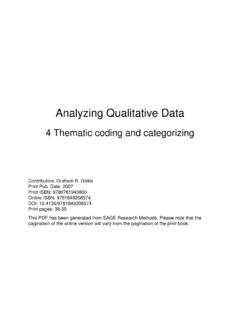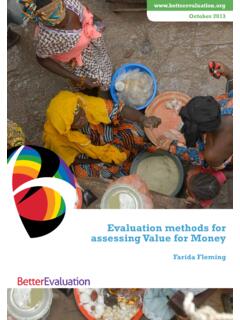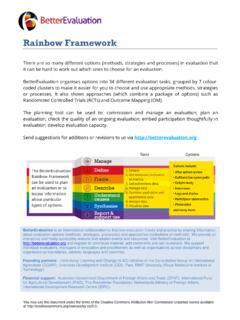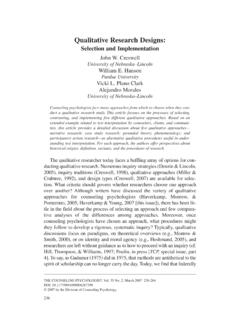Transcription of Introduction to Qualitative Research Methodology
1 Introduction toQualitative Research MethodologyKarina KielmannFabian CataldoJanet Seeley2 Karina Kielmann Senior Lecturer in International Health Institute for International Health & Development Queen Margaret University Edinburgh, Scotland EH21 6UU Email: Karina Kielmann is a medical anthropologist who has been working in international public health since 1998. Her specifi c areas of interest include critical analyses of public health paradigms, patient-provider communication, and bioethics in low-resource settings. She has worked in Kenya, Tanzania, Burkina Faso, India, Zambia, and South Africa. At the time of production of this manual, Karina was based in the Department of Global Health and Development, London School of Hygiene and Tropical Medicine.
2 Fabian Cataldo Research Director - Malawi Dignitas International Box 1071 Zomba; Malawi E-mail: Cataldo is a social anthropologist specialised in questions related to health systems and access to treatment and care in low income settings. Over the past 15 years he has undertaken extensive fi eldwork in Brazil, Belgium, Tunisia, Zambia, Uganda, Zimbabwe, Mozambique and Malawi. He is currently the Research Director of Dignitas International, a medical and Research NGO based in the South-East of Seeley Professor of International Development School of International Development University of East Anglia Norwich, NR4 7TJ, UK E-mail: and Head of the Social Science Programme MRC/UVRI Uganda Research Unit on AIDS Box 49, Entebbe, Uganda E-mail: Janet Seeley is a social anthropologist by training.
3 Over the last 30 years she has undertaken extended periods of Research in Kenya, Uganda, Zambia, India, Nepal, Bangladesh, Pakistan, and Papua New Guinea focusing on broader aspects of people s lives and livelihoods which infl uence health and health-related behaviour. She is currently Professor of International Development at the University of East Anglia and Head, Social Science Programme, MRC/UVRI Uganda Research Unit on AIDS, on partial secondment to the Medical Research Council (UK). Edited and Designed by Write-Arm ( ) December 2011 Contents3 C H A P T E R 1 .. 6 The Qualitative Lens C H A P T E R 2.
4 12 The Quantitative - Qualitative ContinuumC H A P T E R 3 .. 18 Issues in the Design of Qualitative Research C H A P T E R 4 .. 24 InterviewsC H A P T E R 5 .. 33 Group InterviewsC H A P T E R 6 .. 41 ObservationC H A P T E R 7 .. 47 FieldworkC H A P T E R 8 .. 53 Ethics and Logistics of Data CollectionC H A P T E R 9 .. 64 Steps Towards Data Analysis Next Steps .. 70 End Notes .. 71 Feedback on Exercises .. 72 Optional Exercises .. 76 Qualitative Research Methods - A List of Useful References .. 79 Acknowledgements .. 82 Appendix A - Example of a Focus Group Discussion Guide.
5 83 Appendix B - Example of an Interview Guide - .. 84 Semi-Structured Interview Preface About the manualThis manual is based on a course entitled Qualitative Research Methods for Non-Social Scientists which was developed by the authors, and run in Entebbe, Uganda, in March 2010. The course was part of the capacity building efforts of the Evidence for Action Research Programme Consortium, funded by the Department for International Development, UK1. The participants came from Zambia, Malawi and Uganda, most with clinical backgrounds in HIV. Their high levels of motivation and enthusiasm for the course and their desire to build on what they had learnt led to the idea of this manual.
6 Aimed primarily at non-social scientists, the manual is also accessible to a wider audience. 4It introduces Qualitative methods in an interesting and hands-on way to provide you with an understanding of key concepts and methods in Qualitative Research as applied to the fi eld of three authors are trained anthropologists who have been working in health and development for many years. They have conducted Research , taught, and built capacity for Qualitative and applied anthropological Research in different types of health settings in a variety of of the manualThe manual can be used as a stand-alone, self-learning tool by individuals new to the use of social science methods in health Research ; it can also be used by social scientists tasked with conducting short-term training in Qualitative Research methods for applied health Research .
7 The authors have drawn extensively on their own experiences of teaching and using Qualitative Research methods, but they have also tried to synthesise many important insights gained from teachers, colleagues, and scholars, some of whom have been acknowledged in the previous section. There are, of course, many excellent manuals and websites providing introductions to Qualitative methods. The objective here is to complement these more in-depth sources with an overview that introduces the user to the topic and approach. If you would like more information on the different topics covered, an annotated list of other useful references is provided on page objectivesAs you go through this manual, you will learn how to.
8 Understand and describe theoretical and methodological assumptions underlying Qualitative Research Distinguish between quantitative and Qualitative approaches to Research and data Formulate Qualitative Research questions Recognise when and where to use Qualitative Research methods Make practical and logistic decisions in preparation for undertaking Qualitative Research Develop and apply basic study instruments for collection of Qualitative data Record and manage Qualitative data Prepare Qualitative data for analysisStructure of the manualThe manual is organised around three main goals.
9 First, to introduce you to Qualitative thinking and a Qualitative approach in Research (Chapters 1 and 2) Second, to equip you with knowledge to be able to plan and conduct selected Qualitative Research methods (Chapters 3 to 6) Third, to enable you to process the textual data obtained through these methods, and to undertake preliminary steps towards analysis of Qualitative data (Chapters 7 to 9)We emphasise throughout the manual - but particularly in Chapter 8 - that Qualitative Research is not just about applying a different set of tools to gain knowledge, but rather, involves a fundamental shift in the approach to Research , and description of reality.
10 To aid learning, we combine short texts that introduce key concepts with examples to help you understand the ideas and refl ect on their application. The chapters are also interspersed with Boxes, Examples, and Exercises to enhance your learning. Exercises will not only check your understanding of the concepts, but also encourage you to apply some of the gained skills yourself. Feedback on the exercises is provided at the end of the manual so that you can check that you are on the right track. We hope you enjoy working with these materials. While we cannot provide distance learning support we would very much welcome any comments you might have on this manual.












